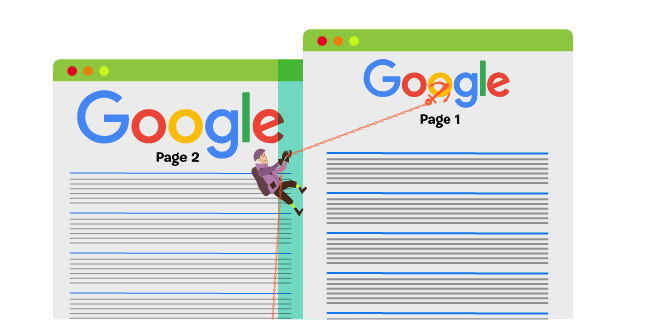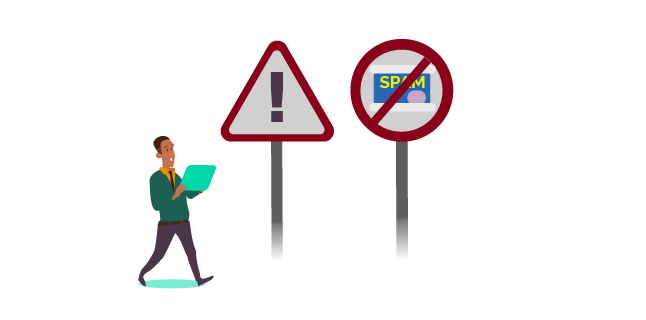Keyword competition is important. And, as with anything in marketing, you always want to run a competition analysis to see how you stand against your competitors.
This is crucial for your keyword research.
The last thing you want to do is waste hours of your valuable time to discover your page isn’t ranking highly.
You can spend all the time in the world writing killer content, optimising it for search engines and your audience. But sometimes, your website might just not be strong enough to take out the bigger competitors.
So, once you found a popular keyword with strong commercial intent, the next step is to check out the competition on Google.
Using Google to Determine Keyword Competitiveness
If the first result is a page that belongs to the website of a high authority big-name brand, then it’s best to consider another keyword. This is because it is very challenging to topple such a webpage from the top position.
Once you take the time to evaluate keyword competition, you can usually find keywords that get excellent search volume AND have little to no competition.

That means that you need less content, links, and promotion to claim your spot on page one.
Using a free Chrome extension called MozBar, you can evaluate keyword competition quickly and easily. It will show up on Google search results so you can quickly see the authority level of that page and site at a glance.
There’s two terms you need to be familiar with when using it:
- Page Authority (PA) – A page with a low PA score means they can be easily knocked off their top results perch. If you see a lot of pages with low PA scores, that means you should go ahead with the keyword.
- Domain Authority (DA) – When Google ranks pages, it favours pages that belong to high authority sites such as Forbes, Wikipedia, and BBC. This means you should keep the DA score in mind before you decide whether to go forward with a keyword.
If a result has both high PA and DA, that means it’s an extremely competitive keyword.

On the other hand, when the top 10 results score low in DA and PA, it indicates that you can easily rank for these keywords. Chances are you have a good chance at climbing the rankings for this keyword.
Overall, PA is a more critical factor than DA. However, you shouldn’t ignore DA completely as it still is a ranking factor.
Please note, PA and DA are relative to your site, for example if you have a really low DA, then it is harder for you to outrank a website with even a modest DA.
Referring Domains
At its very core, Google is a vote collection engine. The more “votes” a page gets (in the form of backlinks), the higher it tends to rank.
That means that the number of websites pointing to that page – also known as referring domains – is worth looking at.

If a website has a strong group of cheerleaders urging Google to rank it highly, then you may struggle to outrank it. But, if it’s a lone fan sat on their own in the crowd, then you can probably outrank them easily.
Because there are several link analysis tools out there, there’s no shortage of conflicting data about how many links a page has pointed to it.
Link Profiles
If you’ve been in the SEO game for a while, you probably know that some link metrics can be VERY misleading.
For example, sites with spam link profiles may boast high DA and PA. However, since they’re using spam links, they’re not going to stick on the first page over the long-term.

If there’s a keyword that looks especially competitive, be wary. If you have a gut feeling there may be black hat SEO behind the results, check before using it. To do this, you can spot check the top 10’s link profile to see where these links are coming from.
Links coming from these places tend to indicate a black hat SEO tactics:
- Low-quality web directories
- Article directories
- Blog networks
- Spam-like blog comments
You may also want to see if any of the top 10 have links that are hard to get for the average marketer. For example, media mentions of leading news outlets, like The New York Times.
Either way, if you’re going to put a lot of effort into ranking for a keyword, try to understand it. It makes sense to understand how each site reached the top, to ascertain which strategies will work best for you. And the best way to do that is to check out their link profile.
Low Hanging Fruits
When you see one or more low hanging fruits in the top 10 – that means pages which are soon going to drop down in their rankings – it means it’s time to do a happy dance.

Because you just found a low-competition keyword!
There are a few results that tend to indicate a low competition keyword:
- Pages with a PA and DA of less than 10
- Ezine Articles
- Yahoo! Answers
- Buzzle
- Squidoo Lenses
- HubPages
- eBay
- Blogspot (or any other free blogging platform)
- Spammy press release sites
If any of these pages look familiar, then you can feel confident. Because creating some quality, engaging and entertaining content is more than likely to rank.
Quality of the Content
Cast your mind back to part 1 of my beginner’s guide to keyword research. We spoke about how keywords aren’t the only way to ensure your website ranks highly. And that you need to make sure your content is the most relevant and fulfils that searcher’s intent.
That means if you want to rank for a competitive keyword, you will need to produce kick-ass content. It needs to match the quality of those that are in the top 10 results.
High-quality content is usually quite long in length (around 2000 words). It’s also well-researched by an expert and quotes relevant sources.
It also tends to be up-to-date, rich with detail, and is displayed in a way which is easy for the reader to consume it. That is, content that’s broken up with paragraphs and images. And content that’s easy to navigate both on a desktop with a mouse and on a mobile by finger.
Sometimes a piece of high-quality content provides useful information, but it is published on a website with an outdated design. This means if you can match the level of quality and produce a modern layout, you can easily beat the old webpage.
Although it may sound like a lot, these ranking factors are seemingly obvious. Especially when you think about what type of content you would want to consume.
Remember, with SEO, it’s all about creating the best possible experience for the user. You should be providing them with easily accessible content that best answers their query.
So, if you’re putting in the time to share your best possible attempt, you shouldn’t struggle to outrank your competitors, Especially when combined with comprehensive keyword competition research.
Finally, It’s Time to Put Your Keyword Research into Action

In part 2 of my beginners guide to keyword research, we looked at how to choose the most valuable keywords.
Once you’ve shortlisted your keywords into the most valuable to your brand it’s time for action. You can start getting creative and producing the content that fulfils those search queries.
You’ll need to create a bank of content before you start to see any results. However, by following the steps in these guides, you’ll be well on the way to climbing the rankings and strengthening your brand’s authority online.
If you can master the art of finding excellent keywords for your business — you’ll not only benefit from more search engine traffic – but you’ll also know your customers better than your competition.
You’ll be able to create content that directly addresses their search queries. And, form valuable connections that will make entering the sales process much easier down the line.
Whenever customers look to make a purchase that is relevant to your brand and industry, you’ll be the first business that comes to their mind. And that is one of the most invaluable parts of digital marketing.
Like SEO, keyword research is a game that never stops. Keep on doing it, again and again, to look for highly profitable keywords.
The path to SEO excellence is not always a smooth-sailing one. And the results won’t be experienced immediately. However, as I mentioned above, if you follow this guide, you will see success in the months to come.
Outsourcing your SEO & Keyword Research to a Marketing Consultant
Keyword research is the crux of all successful SEO and content marketing strategies. Fortunately, it’s very easy to do yourself, with virtually no spend needed. But it’s also an extremely time-consuming process.
If you’re a relatively new start-up or small business owner, you may not have the time needed to fully immerse yourself into your keyword research and content marketing planning. And to get it right, you really need to spend the time focusing on it from the start.
This is where lots of companies decide to outsource their SEO to a marketing consultant. They can fully commit themselves and create a robust strategy to help you achieve the results you’re after.
With over a decade working in digital marketing, I know exactly what it takes to create and implement a successful SEO strategy that can drive lots of high converting traffic to your website.
If you’d like to hear about how my team and I could help you to manage your website’s SEO, why not arrange a call? I’d be happy to have an obligation-free chat with you and walk you through some previous examples of our work.







